How you arrange your furniture really shapes your home’s social vibe. When you set sofas and chairs facing each other, about 4 to 8 feet apart, it’s so much easier for people to talk without raising their voices or craning their necks.
Remember to repin your favorite images!
If you carve out dedicated conversation areas with well-placed seating, you turn any living space into a spot where meaningful interactions just… happen.
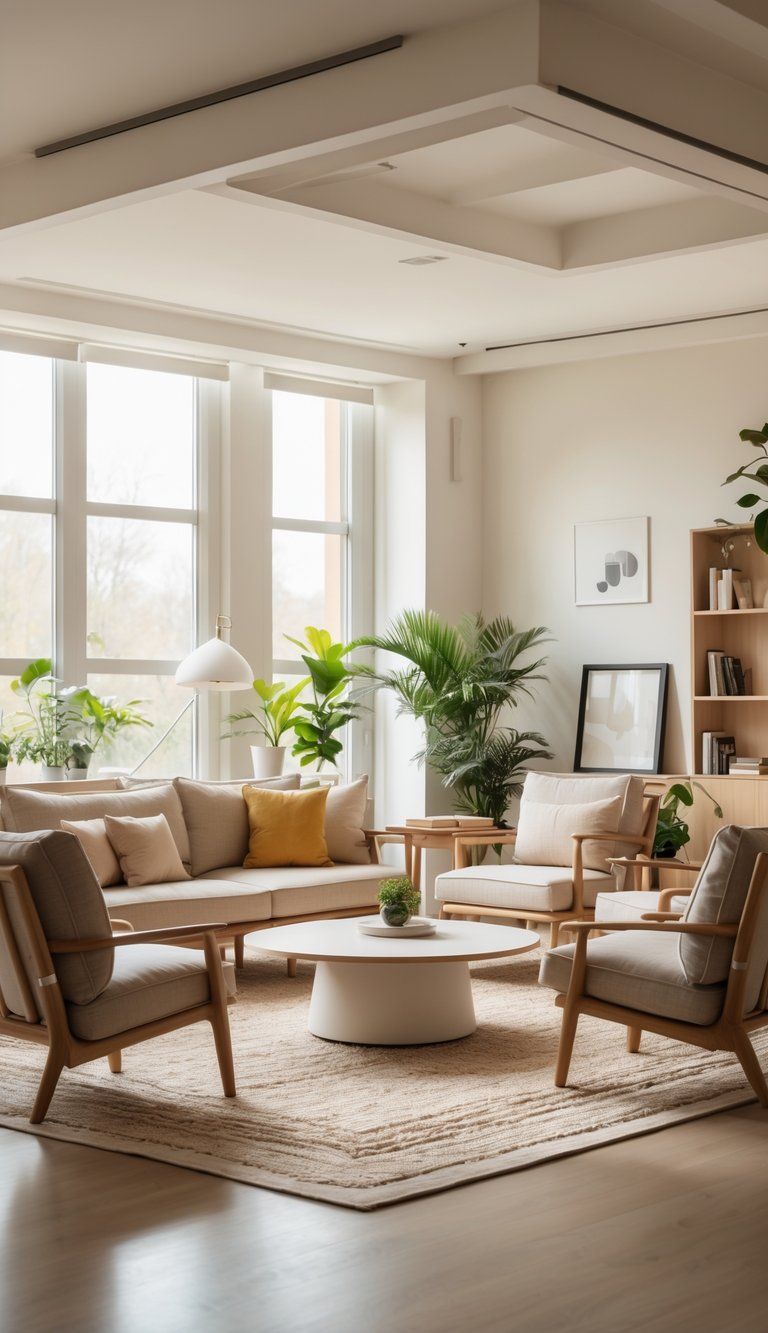
Think back to the last time you genuinely enjoyed chatting in someone’s home. Odds are, the way the furniture was set up made it easy to connect.
Strategic placement creates intimate zones even in big rooms. Area rugs can help define these spots and add a cozy feel.
Coffee tables or ottomans in the middle give everyone a shared focus and a spot for drinks or snacks.
Your living room should feel right for both casual family chats and bigger gatherings. If you group furniture so people face each other instead of just the TV, you’re making a statement that connection matters.
That simple shift can totally change how people interact in your space. Even a quick visit feels warmer and more personal.
Principles of Conversation-Focused Furniture Arrangement
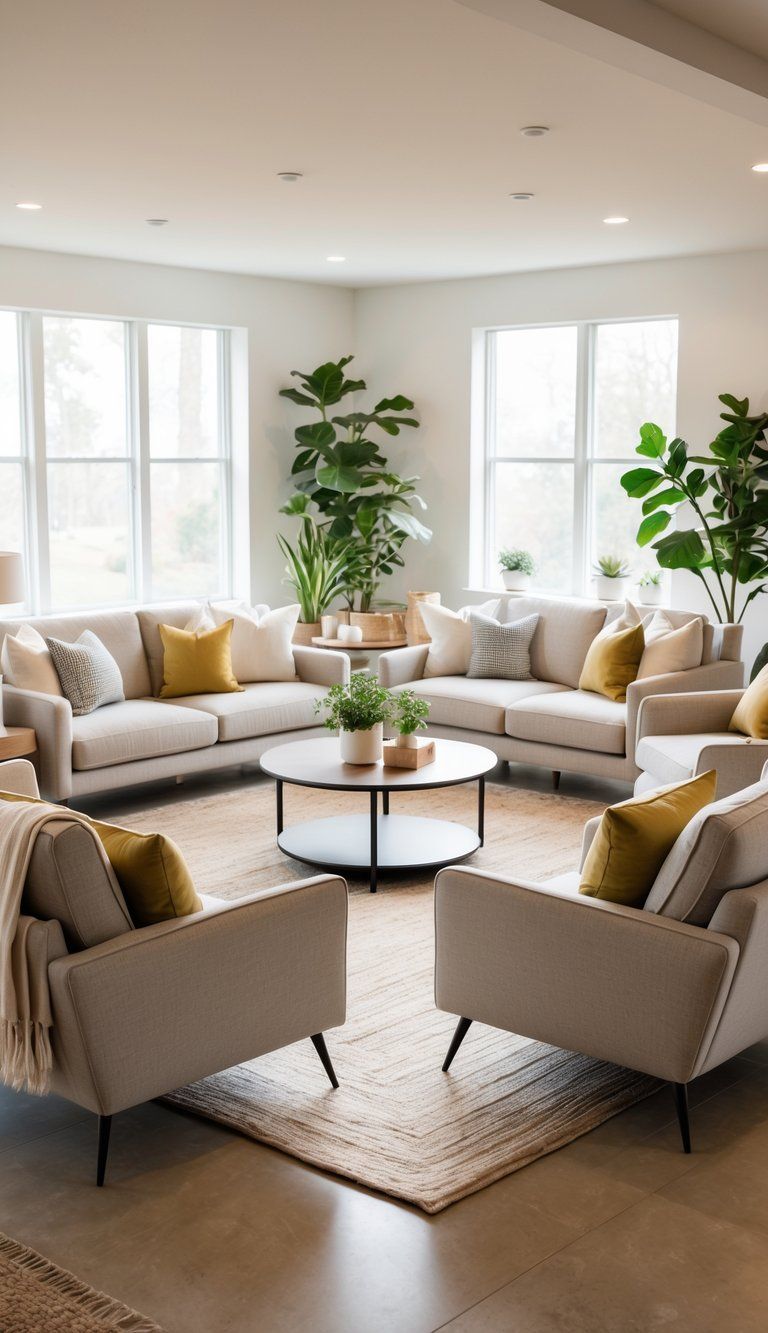
If you want people to connect, you need to plan your furniture layout with care. The right arrangement can make a room feel lively and welcoming instead of just functional.
Defining the Conversation Area
Your conversation area is really the heart of any social space. Start by thinking about how many people you usually have over.
For small gatherings, try a circular seating pattern with 4 to 8 feet between each piece. That’s close enough for easy chatting but not so close it feels cramped.
Mix up your seating:
- Use a main sofa as your anchor
- Place chairs at 90-degree angles
- Add a couple of accent chairs for flexibility
Arrange all seats so they face the center. Studies actually show face-to-face setups boost engagement and help people make eye contact.
For bigger rooms, create several conversation zones instead of pushing everything to the walls. Each spot should feel complete on its own but still connect visually to the rest of the space.
Understanding Traffic Flow
How people move through your room matters more than you might think. Leave about 30 to 36 inches of space between furniture so folks can walk around without bumping into things.
Keep these traffic flow basics in mind:
- Main walkways should go around, not through, conversation areas
- Entry points need to be open, so nobody has to squeeze by a chair
- Paths between seats should be at least 18 inches wide
Before you finalize your layout, watch how people naturally move through the space. Notice where they enter, pause, or head to other rooms.
Try not to put tall furniture where it blocks the view or gets in the way of conversation.
Selecting a Focal Point
A good focal point pulls people together and gives everyone something to talk about. Maybe it’s a fireplace, big window, or a cool piece of art.
Arrange your main seating to face or flank whatever you choose as your focal point. Studies say that a shared visual anchor can actually spark about 20% more conversation—it just gives people something to comment on.
But don’t let the focal point take over:
- Set your biggest sofa opposite it
- Angle other seats around it
- Pop a coffee table or ottoman in the center
- Use lighting to highlight both the focal point and the main seating area
Honestly, the best rooms make the people—not the décor—the real focus. The environment should help, not compete, with socializing.
Choosing the Right Seating Arrangement

Your seating arrangement sets the tone for how people interact. When you get it right, people just feel more at ease and conversation flows.
Optimal Distance and Orientation
Designers often talk about the “conversation zone”—a circle about 7 to 10 feet across where everyone can hear each other easily.
Point sofas and chairs toward each other, keeping them 4 to 8 feet apart. That’s close enough to chat, but not so close that it feels awkward.
Circular or semi-circular layouts work wonders for getting people talking. There’s actually research from UBC’s business school showing circles make folks feel more collaborative and connected, while rectangular setups can feel a bit stiff or competitive.
If you have a TV room, try using chairs or sofas that swivel or move. That way, you can face the screen for movies but swing things around for conversation.
Creating Flexible Extra Seating
Flexibility is key, especially if you host often. Add extra seating that you can pull out for guests and stash away when you don’t need it.
Ottomans are great—they work as both footrests and extra seats. Pick sturdy ones that can handle an adult sitting down.
Floor poufs or big cushions are easy to toss in a corner or basket. They’re great for kids or for a more laid-back vibe.
Benches under windows or along walls blend in but give you more places to sit when friends stop by. Some even have storage inside—handy!
Nesting tables or stools can spread out for extra seating and tuck away to save space.
Balancing Visual Weight
Spread out the “visual weight” in your room so nothing feels lopsided.
Balance heavy stuff like sofas with lighter chairs—maybe something with skinny legs. A mix of heights and shapes keeps things interesting.
Use color to help balance things out. Darker or bold pieces feel heavier, while lighter colors seem to fade back. Play around to see what draws the eye.
If you have a big room, make a couple of conversation areas instead of pushing everything to the edges. It makes the space feel cozier and more intentional.
Furniture Placement Strategies by Room Type
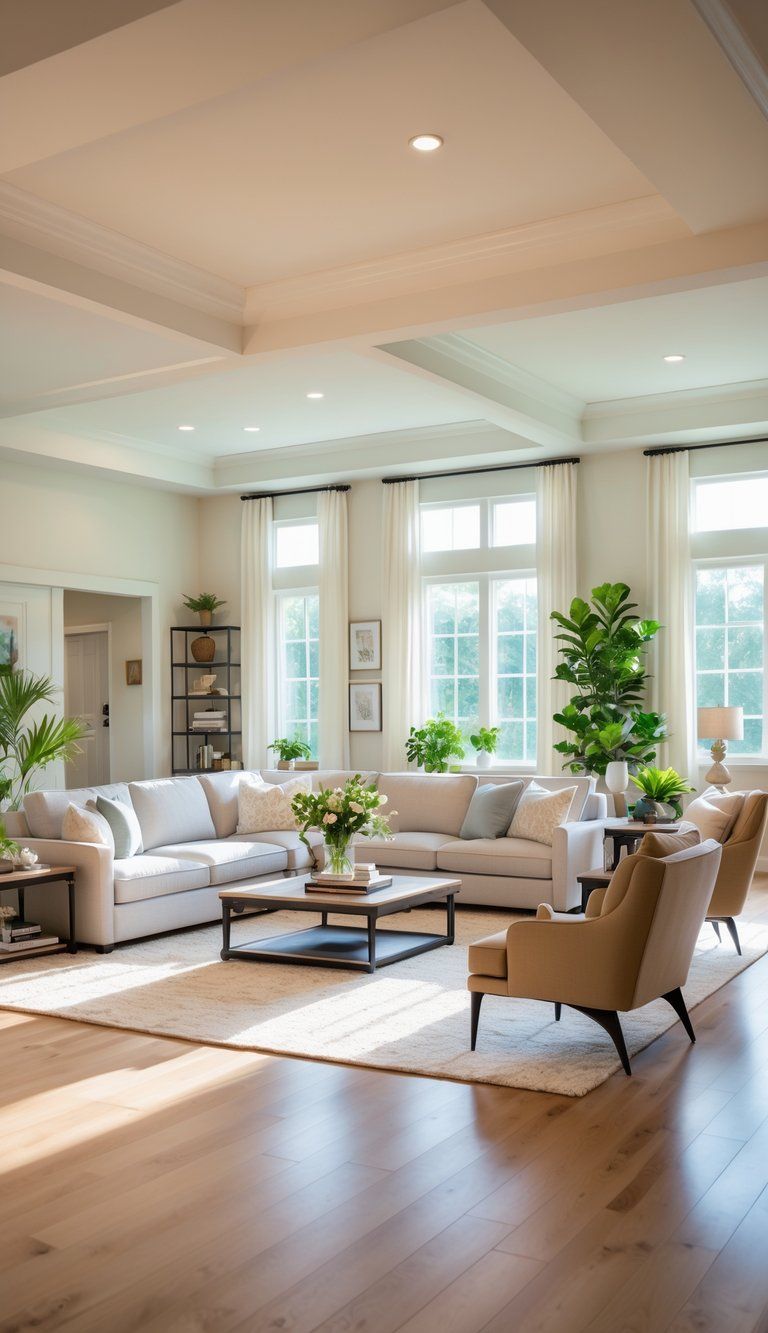
Different rooms need their own approach for good conversation. The right setup can make any space a place where people want to hang out and talk.
Living Room Layouts
Living rooms are usually conversation central. The best setup? Seats facing each other, 4 to 8 feet apart.
Try making a conversation circle: put a sofa and two chairs around a coffee table. People naturally gather and stay within talking distance.
If your living room’s tight on space, you can:
- Swap a loveseat for a big sofa
- Pick slim chairs
- Use side tables instead of a giant coffee table
A good area rug helps define the space. Get one big enough that at least the front legs of your furniture can sit on it.
Skip lining furniture along the walls—it just makes everyone feel far apart and, honestly, a little awkward.
Long Living Room Solutions
Long, narrow living rooms can be tricky. The trick is to make distinct zones without losing the sense of togetherness.
Split the space into two seating areas:
- Main conversation zone with your sofa and chairs
- Smaller grouping at the far end
Let your furniture double as dividers. For example, a console table behind a sofa can mark where one zone ends and another begins, plus it adds storage.
In really narrow rooms, try a sectional along one wall with chairs across from it. You get more seats while keeping that face-to-face feel.
Rugs are extra helpful in long rooms. Use them to carve out each conversation spot and make the space feel less like a hallway.
Dining Room Conversation Settings
Round or square dining tables make conversation easier than rectangles—everyone can see each other, which just feels better. For 4 to 6 people, a 48–60 inch round table is about right.
If you want guests to linger, comfy chairs are a must:
- Supportive backs
- Cushioned seats
- No arms (so people can slide in and out easily)
Lighting matters too. You want it bright enough to see faces but soft enough to feel inviting. A pendant or chandelier 30–36 inches above the table works well.
For big groups, a round table with a lazy Susan in the middle is a game-changer. Passing food is easier, and it gives people something to talk about.
Leave at least 36 inches between the table and walls or other furniture so people can move around and chat comfortably.
Enhancing Conversation with Decor and Accessories
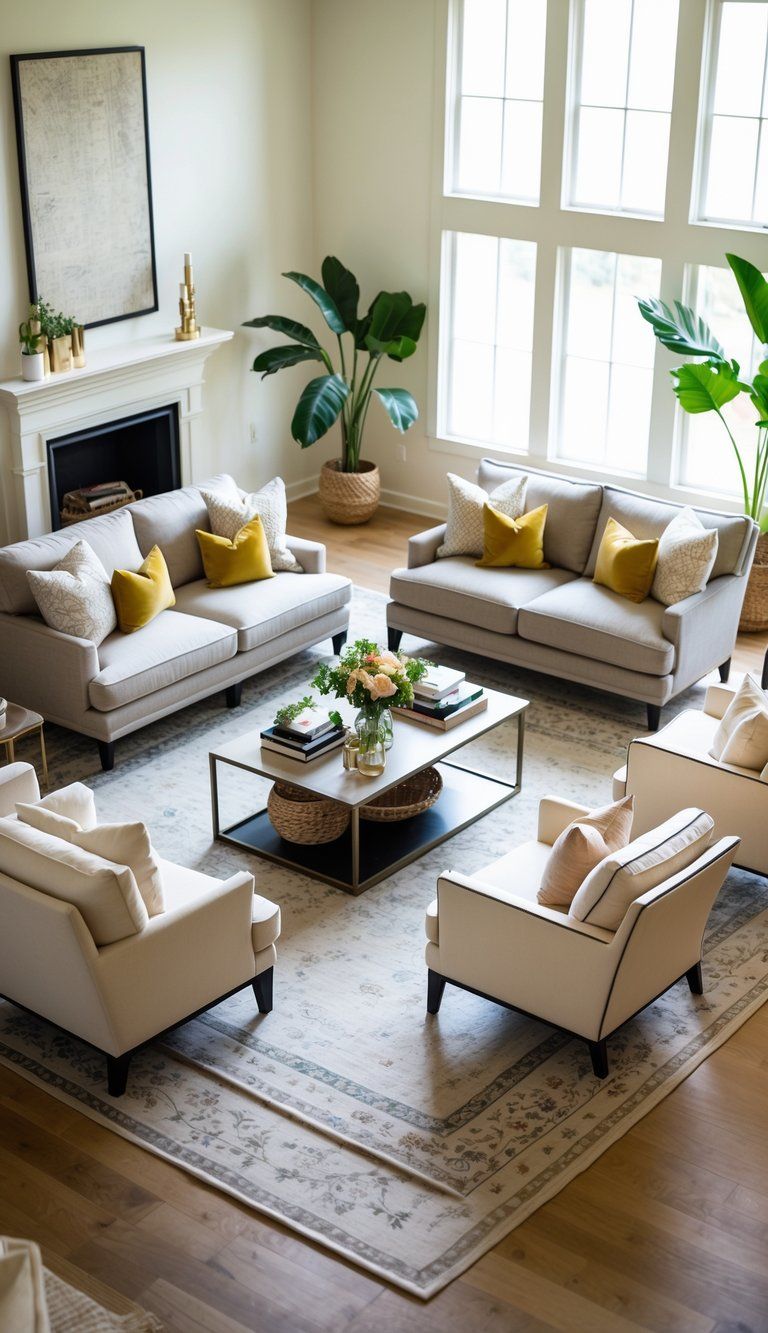
The right accessories can take your conversation area from just okay to really inviting. A few well-chosen pieces make the space feel warm and encourage people to stick around.
Using Area Rugs for Cohesion
Area rugs do a lot more than protect your floors. They anchor your furniture and help organize the room visually.
Pick a rug big enough so the front legs of all your seating land on it. That unifies everything and makes it feel intentional.
Some quick rug tips:
- In open layouts, use rugs to create “rooms within rooms”
- Soft textures make people want to kick off their shoes and relax
- Go for patterns that play nice with your furniture, not compete with it
- For round seating, a circular rug really pulls it together
The texture and color of your rug can change how people interact. Softer rugs make people want to get closer, which can spark better conversation.
Lighting for Warmth and Intimacy
Lighting can make or break a conversation. Harsh overhead lights can feel stressful, while warm, layered lighting helps people open up.
Aim for three types of light in your conversation area:
- Ambient light for general brightness (think recessed lights or chandeliers)
- Task lighting for things like reading (table lamps, pendants)
- Accent lighting for warmth and highlighting features (wall sconces, smaller lamps)
Set table lamps at about eye level when you’re sitting. That gives a flattering glow and helps everyone read facial expressions.
If you can, install dimmers. They let you adjust the mood as needed. And always go for warm bulbs (2700–3000K)—they make the space feel cozy and help conversations last.
Arranging Accent Furniture for Engagement
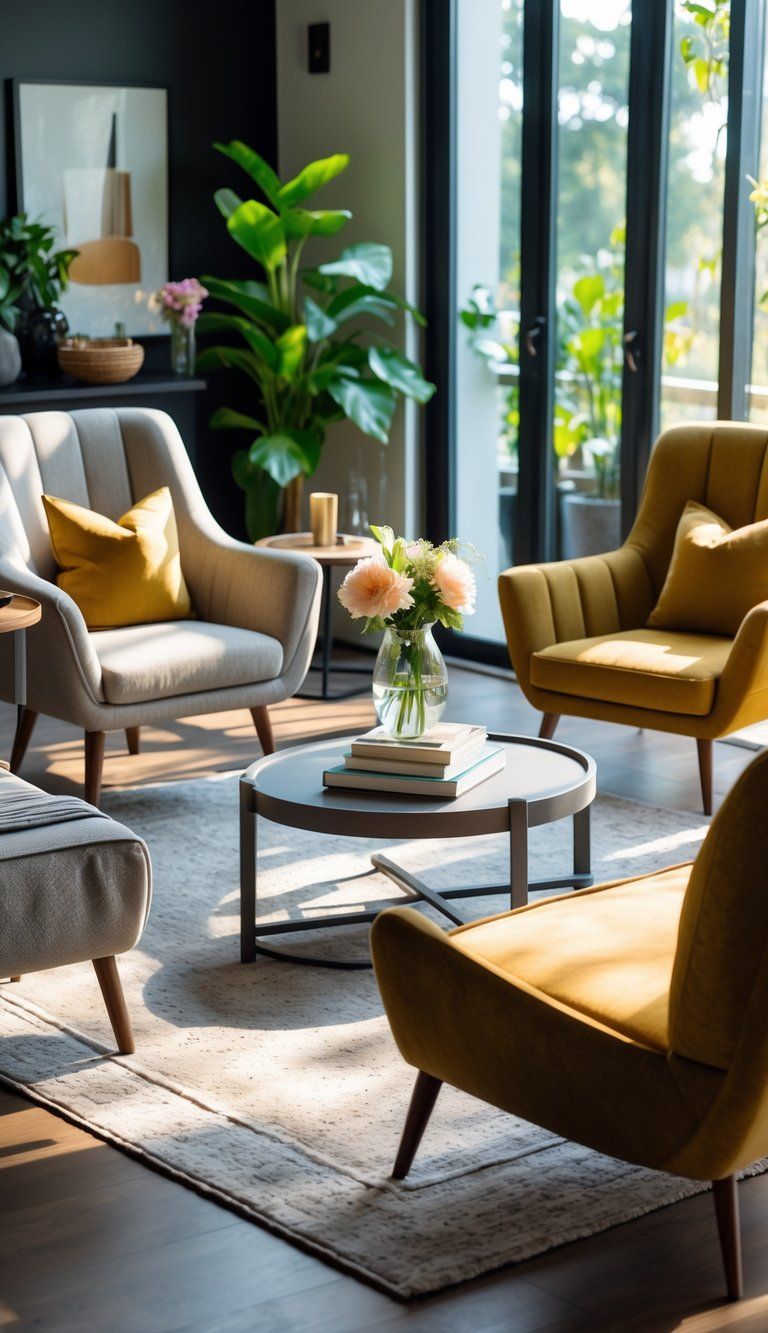
Accent furniture plays a big role in how a conversation area feels. When you place these pieces thoughtfully, they encourage people to gather without making the room feel crowded.
Coffee Tables as Conversation Anchors
Coffee tables aren’t just for holding drinks—they anchor the conversation. Choose one that fits your seating setup; for most rooms, 16–18 inches high is just right so everyone can reach without stretching.
Round or oval coffee tables are usually best. They don’t have sharp corners, are easier to move around, and give everyone equal access.
Keep the table about 18 inches from your seats—close enough to use, but with enough room for legs. For bigger groups, two smaller tables might work better than one big one, so everyone has a spot to set their stuff.
Positioning Accent Pieces
When you place accent furniture thoughtfully, you can really boost how conversations flow in a room. Keep side tables within easy reach of each seat, aiming for about the same height as the chair or sofa arm.
Ottomans do a lot more than you might expect:
- Extra seating when guests show up out of the blue
- Footrests for those long, comfy chats
- Makeshift tables if you just pop a tray on top
Arrange floor and table lamps so they spread light evenly around your conversation area. Try not to put tall pieces, like bookcases or étagères, between people—they just block sightlines and make things awkward.
If you want flexibility, go for lightweight accent chairs. You can move them around easily and expand or shrink your conversation circle as needed.
Integrating Entertainment Centers
You really have to think carefully when adding entertainment centers, or they’ll take over the whole conversation space. Put your TV so it doesn’t grab all the attention—perpendicular to the main seating usually works best, not right in everyone’s line of sight.
Some good options:
- Built-in cabinets that you can close up when you’re not watching
- TV lifts that hide the screen away in furniture
- Wall-mounted systems that save floor space
Keep media components handy but not smack in the middle of everything. Remote caddies and charging stations should be close by, just not the centerpiece.
If your room has to pull double duty, set up distinct zones with area rugs or separate furniture groupings—one for chatting, another for media. That way, neither activity takes over the whole space.
Adapting Spaces for Different Needs
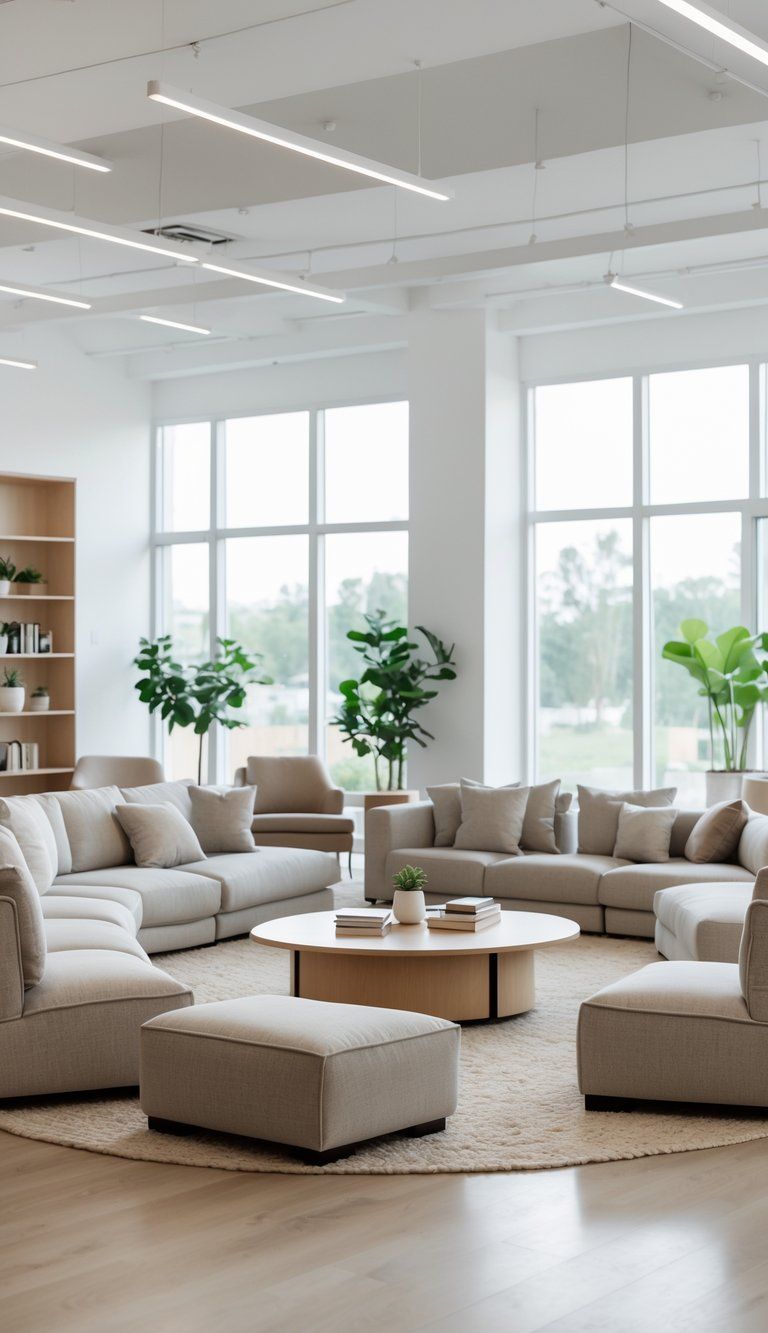
The best furniture setups are the ones that can keep up with your life. With some planning, you can get one space to do a lot without giving up comfort or style.
Creating a Cozy Retreat
If you want a cozy retreat, start by arranging sofas and chairs so they face each other, about 4-7 feet apart. That way, everyone can chat without shouting or straining to hear.
Pile on soft throw pillows and blankets that make people want to sink in and stay. These little touches really make things feel warm and welcoming.
Lighting matters more than you might think. Use floor and table lamps with warm bulbs instead of harsh overhead lights. You’ll get a softer, friendlier glow that makes conversations linger.
Add in an ottoman for extra seating, a spot to prop up your feet, or even as a tray table. It’s a small thing that brings a lot of comfort and function.
Designing an Entertainment Zone
Entertainment zones call for a different setup. Pick a focal point—usually the TV or media center—and arrange your seats so everyone gets a good view.
Sectional sofas are great here. They fit lots of people and keep the space looking pulled together.
Make sure snacks and drinks are always within reach. Coffee tables, side tables, or even nesting tables you can pull out when needed help avoid awkward stretching.
Modular furniture works well for these spaces. Push pieces together for movie night, or pull them apart to make smaller conversation areas for games.
You’ll want storage for games, remotes, and all the other stuff. Ottomans with hidden storage or media consoles with drawers keep things tidy but close at hand.
Optimizing Layouts Based on Size and Shape
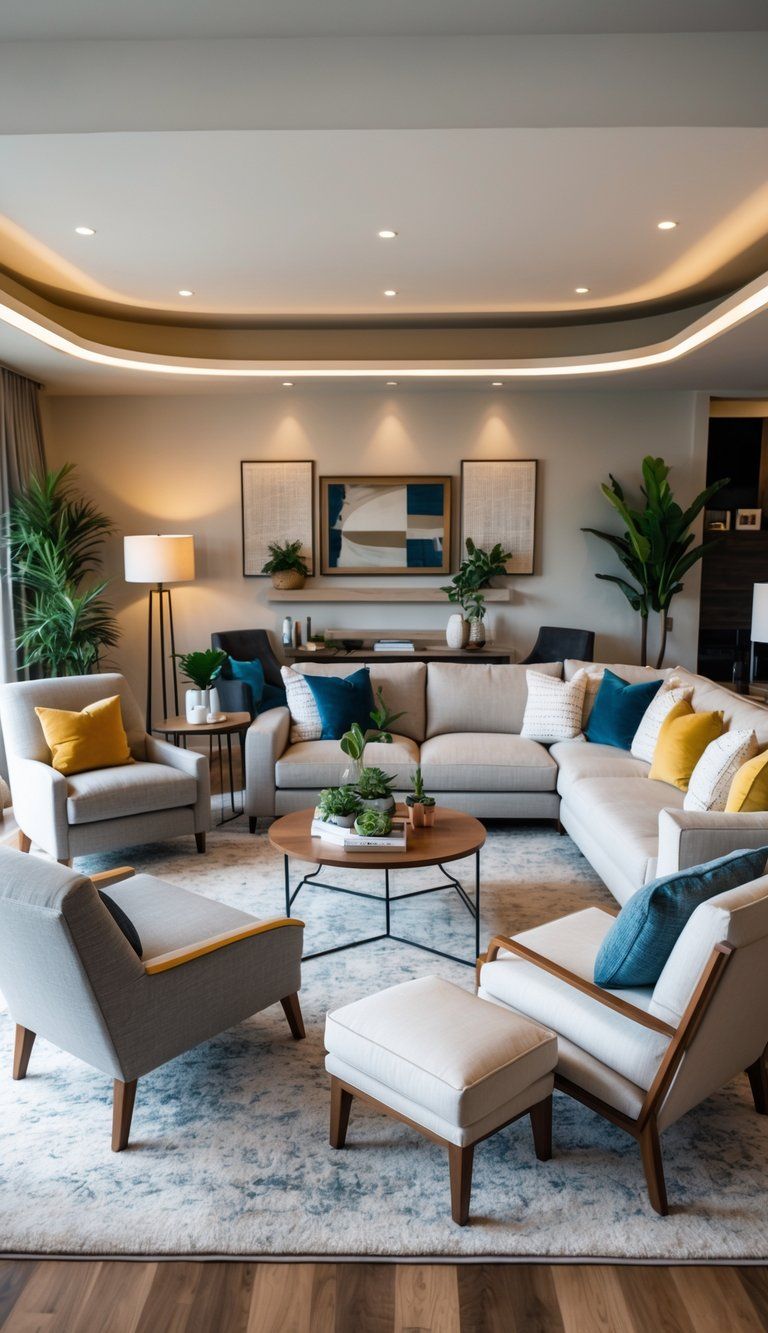
The size and shape of your room make a big difference in how you arrange things for conversation. The right layout makes the most of your space and helps people connect, all while working with what’s already there.
Customizing for Room Dimensions
Square rooms feel balanced and are easy to set up for conversation. Arrange seats in a circle or square, leaving about 8 feet between chairs on opposite sides. Everyone can see each other, and it just feels natural.
If you’ve got a rectangular room, don’t shove all the furniture against the walls. Try floating pieces in the center to make a conversation zone. For narrow rooms, an L-shaped seating area in one corner opens up the rest of the space but still keeps things social.
Big rooms work well with more than one conversation spot. Put your main seating near the focal point, like a fireplace or big window, and set up a smaller group somewhere else.
Small spaces need dual-purpose pieces:
- Ottoman/coffee tables
- Armless chairs
- Low-profile sofas
Utilizing Extendable Dining Tables
Extendable dining tables make it easy to host groups of any size while still keeping conversations flowing. A round extendable table is perfect for square rooms—when you open it up, everyone gets to join in.
Keep the table small for everyday use with 4-6 chairs. When you’re entertaining, just extend it and add more seats. Leave at least 36 inches between the table and the wall so people can move around comfortably.
Table placement tip: Put rectangular extendable tables with one end against the wall most days. For bigger gatherings, pull it out and center it in the room.
Modern drop-leaf tables are a lifesaver in tricky spaces. They sit right up against the wall when you’re not using them, but open up when you need more seats for conversation.
Leveraging Natural Light and Visual Interest
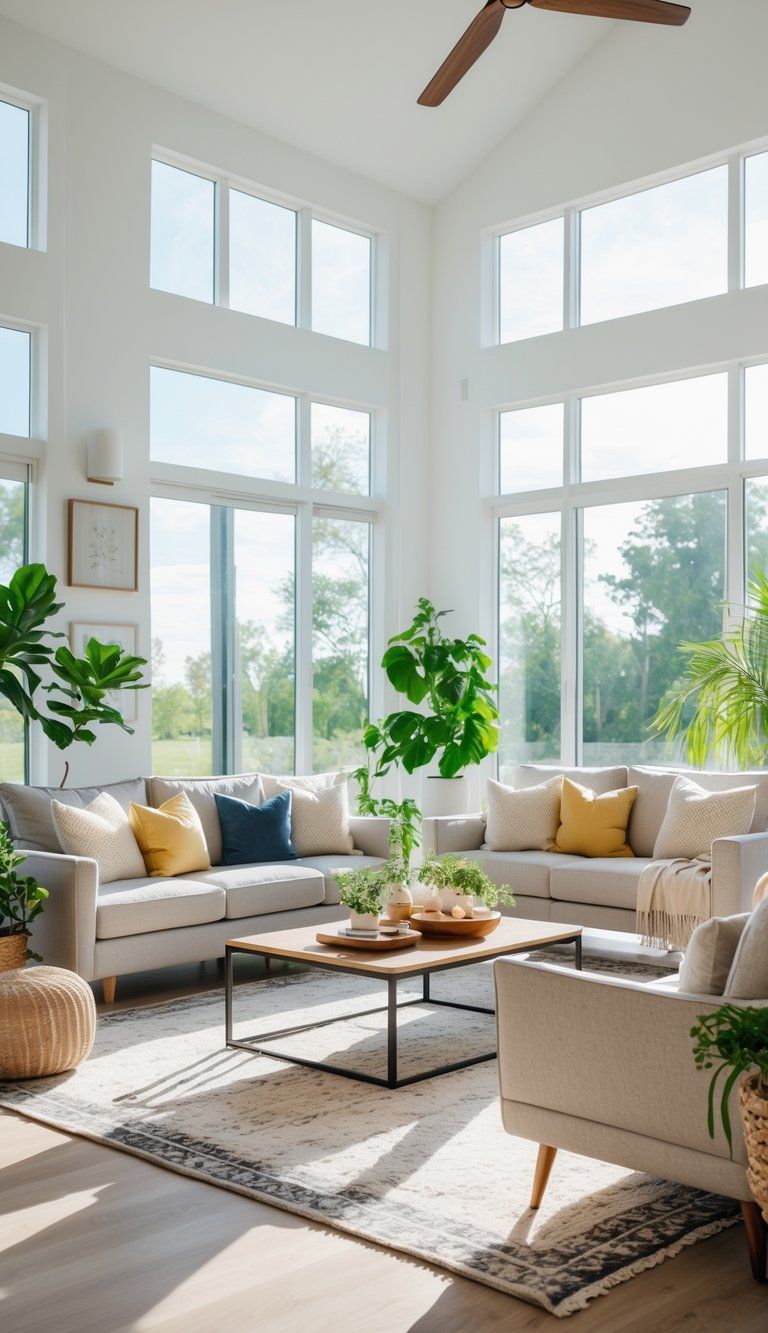
When you arrange furniture with windows and decorative elements in mind, the space just feels more welcoming for conversation. If you’re smart about natural light, you get a room that’s both practical and nice to look at.
Orienting Towards Windows
Set up your conversation area so you get plenty of natural light, but not so much glare that people are squinting. Try putting seats perpendicular to the windows instead of facing them directly.
In the evening, go for soft, ambient lighting at eye level. A couple of table lamps at the ends of the sofa or on side tables make a big difference, adding a warm glow that makes people want to stick around.
Sheer curtains can help filter harsh sunlight while keeping things bright and airy. You’ll get a comfortable space where everyone can see each other—without anyone getting blinded or overheated.
Incorporating Visual Variety
Mixing up textures, colors, and shapes can make your conversation space feel lively and interesting. Just don’t go overboard—too much going on can get distracting fast.
Pick out a statement piece or two. Maybe it’s a funky coffee table, a bold piece of art, or a chair that makes people ask, “Where’d you find that?” These pieces give people something to talk about, and honestly, they just look cool.
Here’s a quick way to keep things balanced:
- Main furniture: Stick with comfy, neutral stuff.
- Accent items: Add 2-3 colors that actually look good together.
- Textures: Throw in a mix—something soft, something rough, maybe a pattern or two.
Play with height while you’re at it. Try a tall floor lamp, some seats at a medium level, and a low table. It keeps the room from feeling flat and makes things more inviting.

